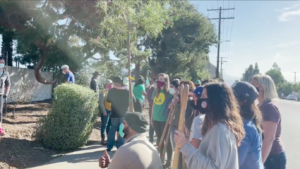By Vanessa Garcia, Kaylenn Gomez, Alahna Martinez and Melody Soto
Climate change has had a huge effect on the world, especially the state of California. There have been warmer summers, and drier seasons.
In this year alone, Californians have been reminded of the many threats to its environment: there was the recent oil spill off the coast of Huntington Beach, a rise in temperatures leading to the hottest summer on record and wildfires.
While these events caused widespread concern, there are other factors contributing to climate change, air pollution and deforestation that don’t make the headlines.
However, there are organizations that are taking steps to prevent more damage.
Trees continue to have a positive effect on the human population. According to the Arbor Day Foundation, trees in Los Angeles remove nearly 2,000 tons of air pollution each year. Trees not only provide us with oxygen, but also save energy. They provide shade during hotter months, and protect people from the high winds during the winter.
City Plants, a public-private partnership between the City of Los Angeles and several local non-profits, plants trees in parts of L.A.that don’t have a lot of tree coverage, focusing especially on areas near schools, and public parks.
“A child living in an area surrounded by trees is three times less likely to visit the emergency room for asthma,” said Gina Ranieri, a project assistant for L.A. Sanitation & Environment, a municipal agency that partners with City Plants.
The L.A. Conservation Corps is an organization founded in 1986. The Corps has also partnered with City Plants as part of their broader conservation efforts. The organization helps remove graffiti, pick up trash from alleys and plant trees.
One of the programs within the organization, The Clean & Green Program, was created in 1988. It reaches working-class and urban neighborhoods including Boyle Heights and Pacoima.
The program employs 14-21-year-olds from these neighborhoods. They serve their cities by planting trees, and removing trash and graffiti.
Carlos Campero, who works as the Director of Conservation Programs for the L.A. Conservation Corps, says their goal is to educate young people about environmental awareness and stewardship. In doing so, they will feel encouraged to make a change. Many of these young people are working their first paid job through the Clean & Green program, Campero said.
“They’re not just coming to work with us and spend seven or eight hours of work time,” Campero says. “But they’re making a difference in their community.”
California has dry air, making it at high risk for fire danger. This summer California recorded it to be one of the warmest seasons yet. Trees benefit neighborhoods, providing shade and cooler temperatures.

Volunteers at a City Plants event in Sun Valley. (Alahna Martinez/CSUN On Point)
While these efforts are underway to plant trees in urban areas to lower temperatures, California’s forests of sequoia are in danger.
The Sequoia Parks Conservancy is a nonprofit that serves to preserve some of the largest trees in the world.
Climate change has caused wildfires to burn at hotter temperatures and spread more rapidly, destroying sequoias in the process
Katie Wightman, field institute director with the Sequoia Parks Conservancy, says that the giant sequoias are amazing trees, but climate change poses new threats to their future survival.
Wightman says that not only are the majestic trees fighting to stay alive by not being consumed by the fires, but they are also facing issues with bark beetles.
“As the drought gets worse, the bark beetle population goes up and the trees lose their natural defence mechanism against those beetles,” says Wightman.
Other organizations, like the Solana Center for Environmental Innovation, focus on other issues. Solana, a nonprofit organization founded in 1983, informs businesses about composting, water conservation and how to ensure less waste ends up in landfills.
Executive Director Jessica Toth explains that aiming for “zero waste” is a lofty, but important goal.
“Zero is tough to get to, but it’s catchy,” Toth says. “It’s important because as an example: we don’t want resources such as recyclable material which can be recycled, to go into the landfill.”
The more people learn about climate change currently happening, the more they will be prone to aid in any way. However, communities that don’t have resources to inform can struggle with knowing how to help.
Rita Kampalath, Sustainability Program Director for L.A. The County’s Chief Sustainability Office, says the communities that don’t have resources or programs such as City Plants, are the same ones who will have a harder time to adapt to climate hazards.
“Climate resilience, the ability to adapt is very much tied into the resources and services the community has,” Kampalath says. “So if people have access to transportation, they’re able to get away.”
Programs such as the ones mentioned above are just a few organizations fighting to keep their communities informed so they can make the necessary changes to fight climate change.
“We need to be making change because that really has a long term impact on our climate, our ability to feed our community, our population,” Toth says.
This story was reported

 Tweet this Video
Tweet this Video Share on Facebook
Share on Facebook Share via E-mail
Share via E-mail

